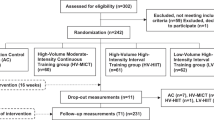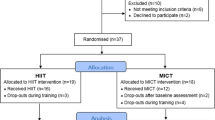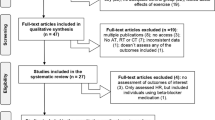Abstract
One bout of aerobic exercise and regular participation in aerobic exercise has been shown to result in a lowering of office and ambulatory blood pressure of hypertensive individuals. Higher-intensity aerobic exercise, up to 70% of maximal oxygen consumption, does not produce a greater hypotensive effect, compared with moderate-intensity aerobic exercise. Intermittent aerobic and anaerobic exercise, however, performed at an intensity >70% of maximal oxygen uptake has been shown to significantly reduce office and ambulatory blood pressure of hypertensive individuals. Thus, faster, more intense forms of exercise can also bring about blood pressure reduction in the hypertensive population. Compared with continuous moderate-intensity aerobic exercise, high-intensity intermittent exercise typically results in a greater aerobic fitness increase in less time and produces greater changes in arterial stiffness, endothelial function, insulin resistance and mitochondrial biogenesis. One of the characteristics of high-intensity intermittent training is that it typically involves markedly lower training volume compared with traditional aerobic and resistance exercise programmes making it a time-efficient strategy to accrue adaptations and blood pressure benefits. This review briefly summarizes the results of studies that have examined the effects of single and repeated bouts of aerobic and resistance exercise on office and ambulatory blood pressure of hypertensive individuals. Then a more detailed summary of studies examining the effect of high-intensity intermittent exercise and training on hypertension is provided.
This is a preview of subscription content, access via your institution
Access options
Subscribe to this journal
Receive 12 digital issues and online access to articles
$119.00 per year
only $9.92 per issue
Buy this article
- Purchase on Springer Link
- Instant access to full article PDF
Prices may be subject to local taxes which are calculated during checkout


Similar content being viewed by others
References
Ostechega Y, Yoon S, Hughes J, Louis T . Hypertension Awareness, Treatment, and Control: Continued Disparities in Adults—United Sates 2005-2006. No. 3. National Centre for Health Statistics: Hyattsville, MD, USA, 2008, 1–8.
Cornelissen VA, Smart NA . Exercise training for blood pressure: a systematic review and meta-analysis. J Am Heart Assoc 2013; 2 (1): e004473.
Cornelissen VA, Buys R, Smart NA . Endurance exercise beneficially affects ambulatory blood pressure: a systematic review and meta-analysis. J Hypertens 2013; 31 (4): 639–648.
Sharman JE, La Gerche A, Coombes JS . Exercise and cardioavscular risk in patients with hypertension. Am J Hypertens 2015; 28 (2): 147–158.
Ciolac EG . High-intensity interval training and hypertension: maximising the benefits of exercise. Am J Cardiovasc Dis 2012; 2 (2): 102–110.
Boutcher SH . High-intensity intermittent exercise and fat loss. J Obes 2011; 2011: 868305.
Gomes Anunciacao P, Doederlein Polito M . A review on post-exercise hypotension in hypertensive individuals. Arq Bras Cardiol 2011; 96 (5): 100–109.
Cardosa CG, Gomides RS, Queiroz AC, Pinto LG, da Silveira Lobo, Tinucci T et al. Acute and chronic effects of aerobic and resistance exercise on ambulatory blood pressure. Clinics 2010; 65 (3): 317–325.
Hardy DO, Tucker LA . The effects of a single bout of strength training on ambulatory blood pressure in 24 mildly hypertensive men. Am J Health Promot 1998; 13: 69–72.
Moraes MR, Bacurau RF, Ramalho JD, Reis FC, Casarini DE, Chagas JR et al. Increase in kinins on post-exercise hypotension in normotensive and hypertensive volunteers. Biol Chem 2007; 388 (5): 533–543.
Melo CM, Alencar Filho AC, Tinucci T, Mion D, Forjaz CL . Postexercise hypotension induced by low-intensity resistance exercise in hypertensive women receiving captopril. Blood Press Monit 2006; 11: 183–189.
Carlson K, Dieberg G, Hess NC, Millar PJ, Smart NA . Isometric exercise training for blood pressure management: a systematic review and meta-analysis. Mayo Clin Proc 2014; 89 (3): 327–334.
Pescatello LS, Fargo AE, Leach CN, Scherzer HH . Short-term effect of dynamic exercise on arterial blood pressure. Circulation 1991; 83: 1557–1561.
Quinn TJ . Twenty-four hour, ambulatory blood pressure responses following acute exercise: impact of exercise intensity. J Hum Hypertens 2000; 14: 547–555.
Eicher JD, Maresh CM, Tongalis CJ, Thompson PD, Pescatello LS . The additive blood pressure lowering effects of exercise intensity on post-exercise hypotension. Am Heart J 2010; 160: 513–520.
de Morais PK, Sales MM, de Almeida JA, Motta-Santos D, de Sousa CV, Simoes HG . Effects of aerobic exercise on 24-h ambulatory blood pressure in individuals with type 2 diabetes and prehypertension. J Phys Ther Sci 2015; 27: 51–56.
Lima LCJ, Assis GV, Hiyane W, Almeida WS, Arsa G, Baldissera V et al. Hypotensive effects of exercise performed around anaerobic threshold in type 2 diabetic patients. Diabetes Res Clin Pract 2008; 81: 216–222.
Trapp EG, Chisholm DJ, Freund J, Boutcher SH . The effects of high-intensity intermittent exercise training on fat loss and fasting insulin levels of young women. Int J Obes 2008; 32 (4): 684–691.
Heydari M, Freund J, Boutcher SH . The effect of high-intensity intermittent exercise on body composition of overweight young males. J Obes 2012; 2012: 480467.
Dunn SL, Siu W, Freund J, Boutcher SH . The effect of a lifestyle intervention on metabolic health in young women. Diabetes Metab Syndr Obes 2014; 7: 437–444.
Tomszak CR, Thompson RB, Paterson I, Schulte F, Cheng-Baron J, Haennel J et al. Effect of acute high-intensity interval exercise on postexercise biventricular function in mild heart failure. J Appl Physiol 2011; 110: 98–106.
da Cunha GA, Santos Rios AC, Moreno JR, Braga PL, Campbel CSG, Simoes HG et al. Post-exercise hypotension in hypertensive individuals submitted to aerobic exercises of alternated intensities and constant intensity exercise. Rev Bras Med Esporte 2006; 12 (6): 281–284.
Ciolac EG, Guimaraes GV, D’Avila VM, Bortolotto LA, Doria EL, Bocchi EA . Acute effects of continuous and interval aerobic exercise on 24-h ambulatory blood pressure in long-term-treated hypertensive patients. Int J Cardiol 2009; 133: 381–387.
Gunjal S, Sinde N, Kazi A, Khatri S . Effect of aerobic interval training on blood pressure and myocardial function in hypertensive patients. Int J Pharma Sci Invest 2013; 2 (6): 27–31.
Mohr M, Nordsborg NB, Lindenskov A, Steinholm H, Nielson HP, Mortensen J et al. High-intensity intermittent swimming improves cardiovascular health status for women with mild hypertension. Biomed Res Int 2014; 2014: 728289.
Nemoto K, Gen-Ho H, Masuki S, Okazaki K, Nose H . Effects of high-intensity interval walking training on physical fitness in middle-aged older people. Mayo Clin Proc 2007; 82 (7): 803–811.
Parpa K, Michaelides MA, Brown BS . Effect of high intensity interval training on heart rate variability in individuals with type 2 diabetes. J Exer Phys 2009; 12 (7): 23–29.
Tjonna AE, Lee SJ, Rognmo O, Stolen TO, Bye A, Haram PM et al. Aerobic interval training versus continuous moderate exercise as a treatment for the metabolic syndrome: a pilot study. Circulation 2008; 118 (4): 346–354.
Munk PS, Staal EM, Butt NB, Isaksen K, Larsen AI . Aerobic interval training versus continuous moderate exercise after coronary artery bypass surgery: a randomized study of cardiovascular effects and quality of life. Am Heart J 2009; 158: 1031–1037.
Rognmo O, Hetland E, Helgerud J, Hoff J, Slordahl S . High intensity aerobic interval exercise is superior to moderate intensity exercise for increasing aerobic capacity in patients with coronary artery disease. Eur J Cardiovasc Prev Rehabil 2004; 11: 216–222.
Warburton DER, McKenzie DC, Haykowsky MJ, Taylor A, Shoemaker P, Ignaszewski AP et al. Effectiveness of high-intensity interval training for the rehabilitation of patients with coronary artery disease. Am J Cardiol 2005; 95: 1080–1084.
Wisloff U, Stoylen A, Loennechen JP, Bruvold M, Rognmo O, Haram PM et al. Superior cardiovascular effect of aerobic interval training versus moderate continuous training in heart failure patients: a randomized study. Circulation 2007; 115 (24): 3086–3094.
Guimaraes GV, Ciolac EG, Carvalho VO, D’Avila M, Bortolotto LA, Bocchi EA . Effects of continuous vs interval exercise training on blood pressure and arterial stiffness in treated hypertension. Hypertens Res 2010; 33: 627–633.
Molmen-Hansen HE, Stolen T, Tjonna AE, Aamot IL, Ekeberg IS, Tyldum GA et al. Aerobic interval training reduces blood pressure and improves myocardial function in hypertensive patients. Eur J Prev Cardiol 2011; 19 (2): 151–160.
Jones H, George K, Edwards B, Atkinson G . Exercise intensity and blood pressure during sleep. Am Heart J 2009; 30 (2): 94–99.
MacDonald JR . Potential causes, mechansims, and implications of post exercise hypotension. J Hum Hypertens 2002; 6: 225–226.
Milanovic Z, Sporis G, Weston M . Effectiveness of high-intensity interval training (HIT) and continuous training for V̇O2max improvements: a systematic review and meta-analysis of controlled trials. Sports Med 2015; 61: 233–239.
Halliwill JR, Taylor JA, Eckberg DL . Impaired sympathetic vascular regulation in humans after acute dynamic exercise. J Physiol 1996; 495 (Pt 1): 279–288.
Halliwill JR, Buck TM, Lacewell AN, Romero SA . Postexercise hypotension and sustained postexercise vasodilatation: what happens after we exercise. Exp Physiol 2013; 98: 7–18.
Author information
Authors and Affiliations
Corresponding author
Ethics declarations
Competing interests
The authors declare no conflict of interest.
Rights and permissions
About this article
Cite this article
Boutcher, Y., Boutcher, S. Exercise intensity and hypertension: what’s new?. J Hum Hypertens 31, 157–164 (2017). https://doi.org/10.1038/jhh.2016.62
Received:
Revised:
Accepted:
Published:
Issue Date:
DOI: https://doi.org/10.1038/jhh.2016.62
This article is cited by
-
Comparative efficacy of exercise training processes in improving nonalcoholic fatty liver disease: a systematic review and meta-analysis
Irish Journal of Medical Science (1971 -) (2023)
-
The Effect of Different Exercise Modes and Intensities on Blood Pressure in African Americans Group: a Systematic Review
Journal of Science in Sport and Exercise (2023)
-
The Intersection of Prostate Cancer and Hypertension: a Call to Action
Current Treatment Options in Oncology (2023)
-
Inhibition of Rho/ROCK signaling pathway participates in the cardiac protection of exercise training in spontaneously hypertensive rats
Scientific Reports (2022)
-
Isometric handgrip exercise training reduces resting systolic blood pressure but does not interfere with diastolic blood pressure and heart rate variability in hypertensive subjects: a systematic review and meta-analysis of randomized clinical trials
Hypertension Research (2021)



